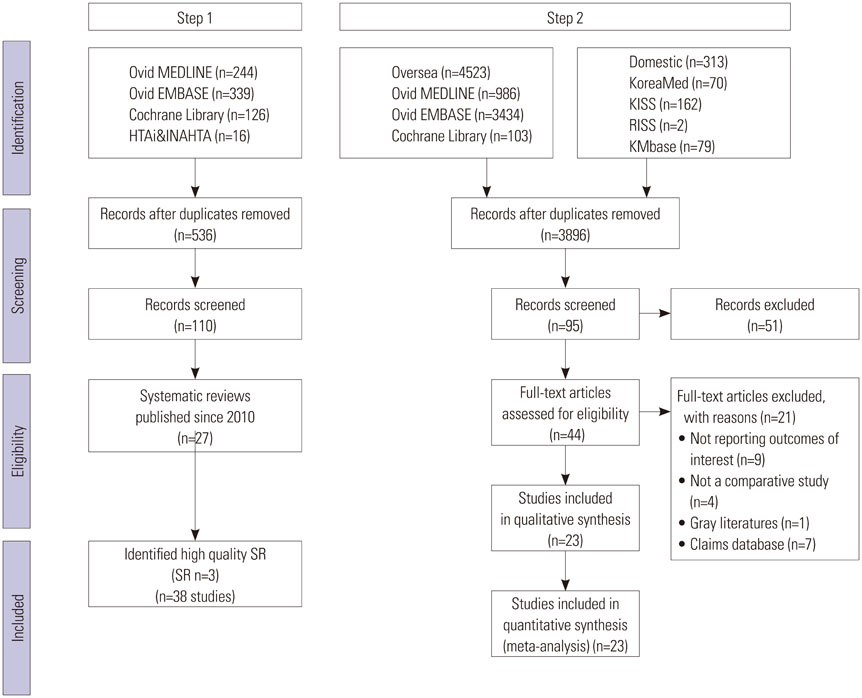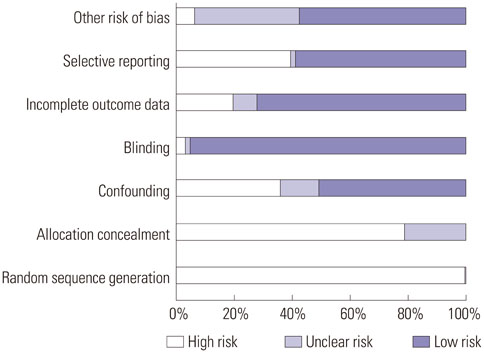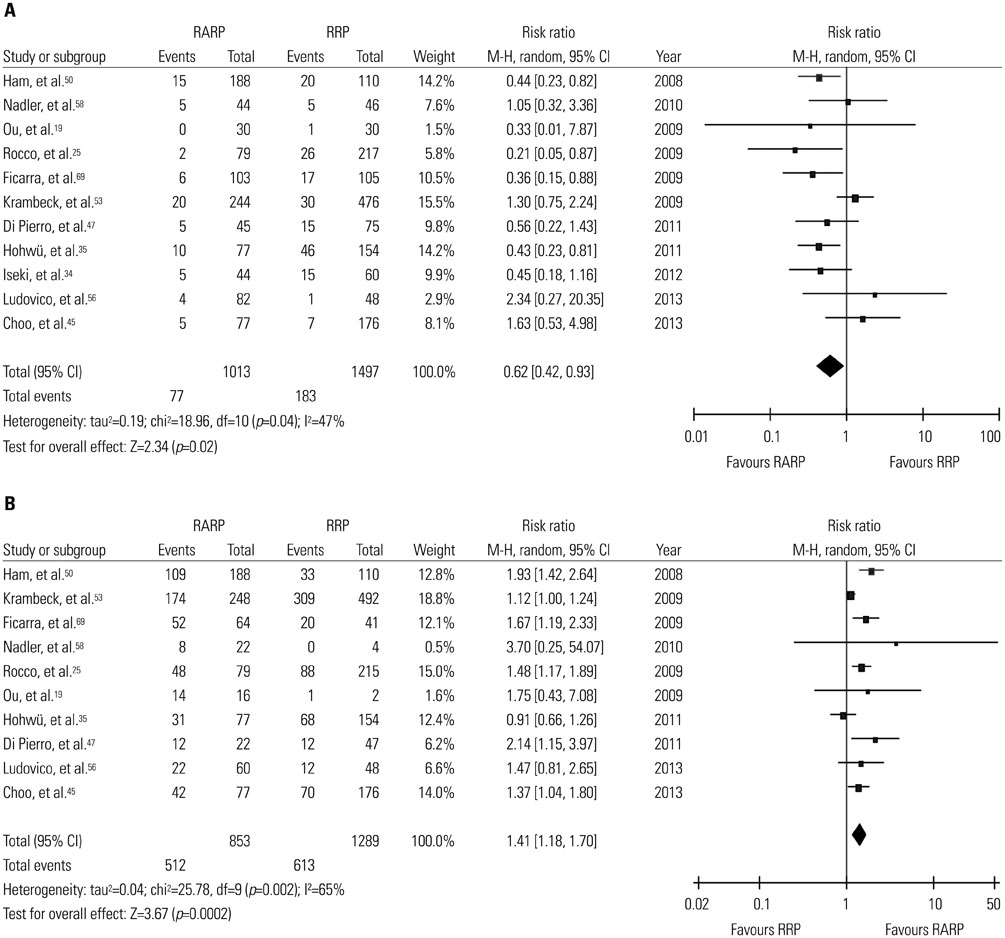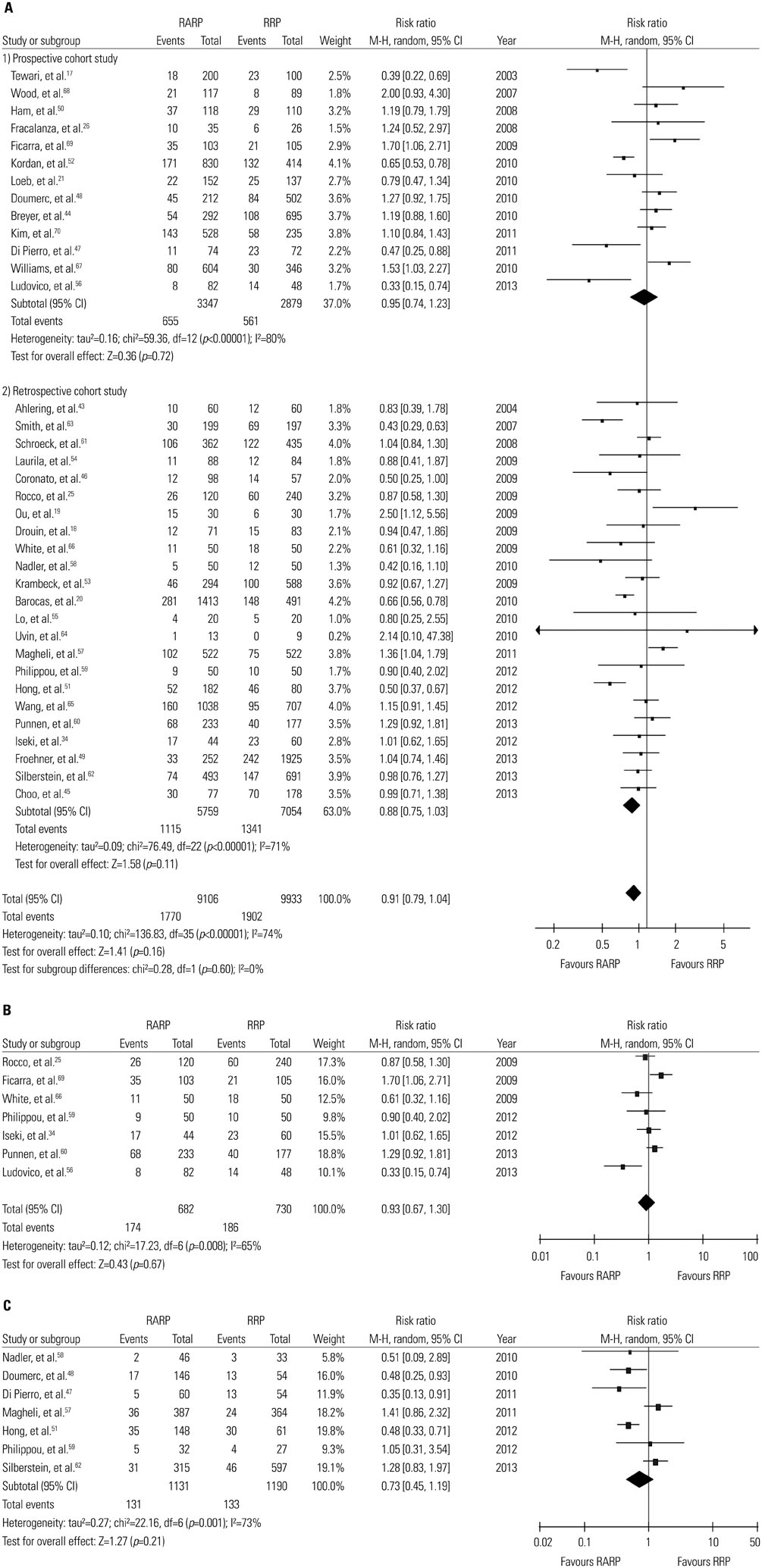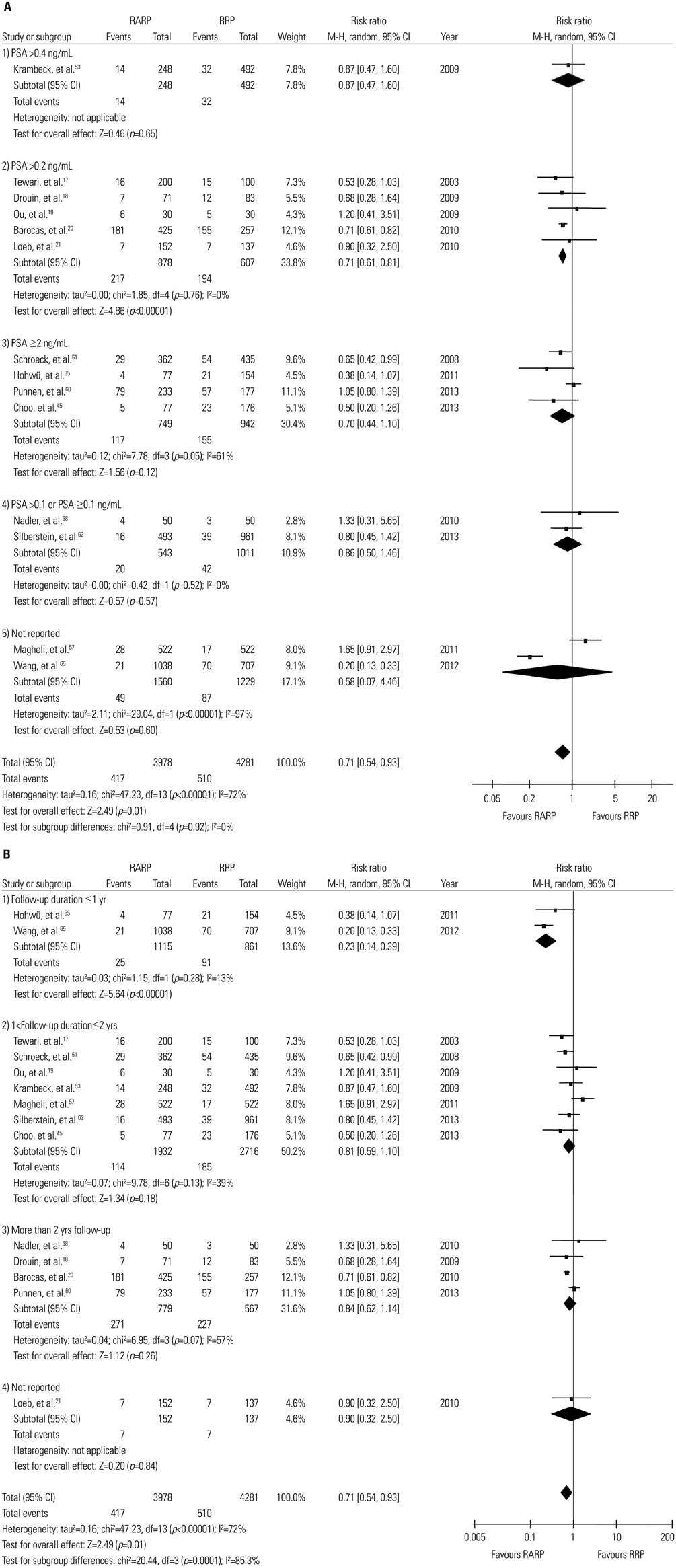Yonsei Med J.
2016 Sep;57(5):1165-1177. 10.3349/ymj.2016.57.5.1165.
Comparison of Robot-Assisted Radical Prostatectomy and Open Radical Prostatectomy Outcomes: A Systematic Review and Meta-Analysis
- Affiliations
-
- 1Department of Nursing, College of Medicine, Chosun University, Gwangju, Korea.
- 2Department of Health Technology Assessment, National Evidence-based Healthcare Collaborating Agency, Seoul, Korea.
- 3Department of Health Policy and Hospital Management, Graduate School of Public Health, Korea University, Seoul, Korea.
- 4Department of Urology, CHA Gangnam Medical Center, CHA University, Seoul, Korea.
- 5Department of Urology, Urological Science Institute, Yonsei University College of Medicine, Seoul, Korea. khrha@yuhs.ac
- 6Department of Nursing Science, College of Nursing, Gachon University, Incheon, Korea. sunarea87@gachon.ac.kr
- KMID: 2374162
- DOI: http://doi.org/10.3349/ymj.2016.57.5.1165
Abstract
- PURPOSE
To systematically update evidence on the clinical efficacy and safety of robot-assisted radical prostatectomy (RARP) versus retropubic radical prostatectomy (RRP) in patients with prostate cancer.
MATERIALS AND METHODS
Electronic databases, including ovidMEDLINE, ovidEMBASE, the Cochrane Library, KoreaMed, KMbase, and others, were searched, collecting data from January 1980 to August 2013. The quality of selected systematic reviews was assessed using the revised assessment of multiple systematic reviews and the modified Cochrane Risk of Bias tool for non-randomized studies.
RESULTS
A total of 61 studies were included, including 38 from two previous systematic reviews rated as best available evidence and 23 additional studies that were more recent. There were no randomized controlled trials. Regarding safety, the risk of complications was lower for RARP than for RRP. Among functional outcomes, the risk of urinary incontinence was lower and potency rate was significantly higher for RARP than for RRP. Regarding oncologic outcomes, positive margin rates were comparable between groups, and although biochemical recurrence (BCR) rates were lower for RARP than for RRP, recurrence-free survival was similar after long-term follow up.
CONCLUSION
RARP might be favorable to RRP in regards to post-operative complications, peri-operative outcomes, and functional outcomes. Positive margin and BCR rates were comparable between the two procedures. As most of studies were of low quality, the results presented should be interpreted with caution, and further high quality studies controlling for selection, confounding, and selective reporting biases with longer-term follow-up are needed to determine the clinical efficacy and safety of RARP.
Keyword
MeSH Terms
Figure
Cited by 2 articles
-
Robotic Radical Prostatectomy: What Do We Really Know about Its Outcomes?
Angelo Naselli
Yonsei Med J. 2016;57(5):1053-1053. doi: 10.3349/ymj.2016.57.5.1053.Changes in health-related quality of life after radical prostatectomy for prostate cancer: A longitudinal cohort study in Korea
Sahyun Pak, Myong Kim, Hanjong Ahn
Investig Clin Urol. 2018;59(5):313-320. doi: 10.4111/icu.2018.59.5.313.
Reference
-
1. Yates DR, Vaessen C, Roupret M. From Leonardo to da Vinci: the history of robot-assisted surgery in urology. BJU Int. 2011; 108:1708–1713.
Article2. Rha KH. Robot-assisted laparoscopic radical prostatectomy. Korean J Urol. 2009; 50:97–104.
Article3. Heidenreich A, Bellmunt J, Bolla M, Joniau S, Mason M, Matveev V, et al. EAU guidelines on prostate cancer. Part 1: screening, diagnosis, and treatment of clinically localised disease. Eur Urol. 2011; 59:61–71.
Article4. Hakimi AA, Feder M, Ghavamian R. Minimally invasive approaches to prostate cancer: a review of the current literature. Urol J. 2007; 4:130–137.5. Kang DC, Hardee MJ, Fesperman SF, Stoffs TL, Dahm P. Low quality of evidence for robot-assisted laparoscopic prostatectomy: results of a systematic review of the published literature. Eur Urol. 2010; 57:930–937.
Article6. Shin CM, Lee YJ, Suh HS, Jang BH, Park JE, Son HJ, et al. Safety and Effectiveness of Robot Surgery. Seoul: National Evidence-based Healthcare Collaborating Agency;2011.7. Moran PS, O'Neill M, Teljeur C, Flattery M, Murphy LA, Smyth G, et al. Robot-assisted radical prostatectomy compared with open and laparoscopic approaches: a systematic review and meta-analysis. Int J Urol. 2013; 20:312–321.
Article8. Kim Y. Towards universal coverage: an evaluation of the benefit enhancement plan for four major conditions in Korean National Health Insurance. J Korean Med Assoc. 2014; 57:198–203.
Article9. Agency for Healthcare Research and Quality. Using existing systematic reviews to replace de novo processes in conducting comparative effectiveness reviews 2013. accessed on 2016 April 26. Available at: https://effectivehealthcare.ahrq.gov/repFiles/methodsguide/systematicreviewsreplacedenovo.pdf.10. Health Information and Quality Authority. Health technology assessment of robot-assisted surgery in selected surgical procedures 2011. accessed on 2016 April 26. Available at: https://www.google.co.kr/url?sa=t&rct=j&q=&esrc=s&source=web&cd=1&ved=0ahUKEwjm5pX4_KvMAhWBLKYKHftsALkQFggiMAA&url=https%3A%2F%2Fwww.hiqa.ie%2Fsystem%2Ffiles%2FHTA-robotassisted-surgery.pdf&usg=AFQjCNF33ID0LDoPAIIyxz8SEJprheEHZw&bvm=bv.120551593,d.dGo&cad=rjt.11. Ramsay C, Pickard R, Robertson C, Close A, Vale L, Armstrong N, et al. Systematic review and economic modelling of the relative clinical benefit and cost-effectiveness of laparoscopic surgery and robotic surgery for removal of the prostate in men with localised prostate cancer. Health Technol Assess. 2012; 16:1–313.
Article12. Kung J, Chiappelli F, Cajulis OO, Avezova R, Kossan G, Chew L, et al. From systematic reviews to clinical recommendations for evidence-based health care: validation of revised assessment of multiple systematic reviews (R-AMSTAR) for grading of clinical relevance. Open Dent J. 2010; 4:84–91.
Article13. DerSimonian R, Laird N. Meta-analysis in clinical trials. Control Clin Trials. 1986; 7:177–188.
Article14. Mantel N, Haenszel W. Statistical aspects of the analysis of data from retrospective studies of disease. J Natl Cancer Inst. 1959; 22:719–748.15. Schroll JB, Moustgaard R, Gøtzsche PC. Dealing with substantial heterogeneity in Cochrane reviews. Cross-sectional study. BMC Med Res Methodol. 2011; 11:22.
Article16. Egger M, Davey Smith G, Schneider M, Minder C. Bias in metaanalysis detected by a simple, graphical test. BMJ. 1997; 315:629–634.
Article17. Tewari A, Srivasatava A, Menon M; Members of the VIP Team. A prospective comparison of radical retropubic and robot-assisted prostatectomy: experience in one institution. BJU Int. 2003; 92:205–210.
Article18. Drouin SJ, Vaessen C, Hupertan V, Comperat E, Misraï V, Haertig A, et al. Comparison of mid-term carcinologic control obtained after open, laparoscopic, and robot-assisted radical prostatectomy for localized prostate cancer. World J Urol. 2009; 27:599–605.
Article19. Ou YC, Yang CR, Wang J, Cheng CL, Patel VR. Comparison of robotic-assisted versus retropubic radical prostatectomy performed by a single surgeon. Anticancer Res. 2009; 29:1637–1642.20. Barocas DA, Salem S, Kordan Y, Herrell SD, Chang SS, Clark PE, et al. Robotic assisted laparoscopic prostatectomy versus radical retropubic prostatectomy for clinically localized prostate cancer: comparison of short-term biochemical recurrence-free survival. J Urol. 2010; 183:990–996.
Article21. Loeb S, Epstein JI, Ross AE, Schultz L, Humphreys EB, Jarow JP. Benign prostate glands at the bladder neck margin in robotic vs open radical prostatectomy. BJU Int. 2010; 105:1446–1449.
Article22. Hu JC, Gu X, Lipsitz SR, Barry MJ, D'Amico AV, Weinberg AC, et al. Comparative effectiveness of minimally invasive vs open radical prostatectomy. JAMA. 2009; 302:1557–1564.
Article23. Lee SH, Kim JH, Whang JS, Choi JE, Shin EH, Lee NR, et al. Clinical effectiveness and safety of robotic surgery. Seoul: National Evidence-based Healthcare Collaborating Agency;2014.24. Novara G, Ficarra V, Rosen RC, Artibani W, Costello A, Eastham JA, et al. Systematic review and meta-analysis of perioperative outcomes and complications after robot-assisted radical prostatectomy. Eur Urol. 2012; 62:431–452.
Article25. Rocco B, Matei DV, Melegari S, Ospina JC, Mazzoleni F, Errico G, et al. Robotic vs open prostatectomy in a laparoscopically naive centre: a matched-pair analysis. BJU Int. 2009; 104:991–995.
Article26. Fracalanza S, Ficarra V, Cavalleri S, Galfano A, Novara G, Mangano A, et al. Is robotically assisted laparoscopic radical prostatectomy less invasive than retropubic radical prostatectomy? Results from a prospective, unrandomized, comparative study. BJU Int. 2008; 101:1145–1149.
Article27. Tomaszewski JJ, Matchett JC, Davies BJ, Jackman SV, Hrebinko RL, Nelson JB. Comparative hospital cost-analysis of open and robotic-assisted radical prostatectomy. Urology. 2012; 80:126–129.
Article28. Nakamura LY, Nunez RN, Castle EP, Andrews PE, Humphreys MR. Different approaches to an inguinal hernia repair during a simultaneous robot-assisted radical prostatectomy. J Endourol. 2011; 25:621–624.
Article29. Ficarra V, Novara G, Rosen RC, Artibani W, Carroll PR, Costello A, et al. Systematic review and meta-analysis of studies reporting urinary continence recovery after robot-assisted radical prostatectomy. Eur Urol. 2012; 62:405–417.
Article30. Haglind E, Carlsson S, Stranne J, Wallerstedt A, Wilderäng U, Thorsteinsdottir T, et al. Urinary incontinence and erectile dysfunction after robotic versus open radical prostatectomy: a prospective, controlled, nonrandomised trial. Eur Urol. 2015; 68:216–225.
Article31. Costello AJ, Brooks M, Cole OJ. Anatomical studies of the neurovascular bundle and cavernosal nerves. BJU Int. 2004; 94:1071–1076.
Article32. McGlynn B, Al-Saffar N, Begg H, Gurun M, Hollins G, McPhee S, et al. Management of urinary incontinence following radical prostatectomy. Urol Nurs. 2004; 24:475–482. 51533. Moore KN, Truong V, Estey E, Voaklander DC. Urinary incontinence after radical prostatectomy: can men at risk be identified preoperatively? J Wound Ostomy Continence Nurs. 2007; 34:270–279.34. Iseki R, Ohori M, Hatano T, Tachibana M. [Urinary incontinence in early experience with robot-assisted laparoscopic prostatectomycomparison with radical retropubic prostatectomy]. Hinyokika Kiyo. 2012; 58:409–414.35. Hohwü L, Borre M, Ehlers L, Venborg Pedersen K. A short-term cost-effectiveness study comparing robot-assisted laparoscopic and open retropubic radical prostatectomy. J Med Econ. 2011; 14:403–409.
Article36. Milsom I, Coyne KS, Nicholson S, Kvasz M, Chen CI, Wein AJ. Global prevalence and economic burden of urgency urinary incontinence: a systematic review. Eur Urol. 2014; 65:79–95.
Article37. Jannini EA, Sternbach N, Limoncin E, Ciocca G, Gravina GL, Tripodi F, et al. Health-related characteristics and unmet needs of men with erectile dysfunction: a survey in five European countries. J Sex Med. 2014; 11:40–50.
Article38. Tewari A, Sooriakumaran P, Bloch DA, Seshadri-Kreaden U, Hebert AE, Wiklund P. Positive surgical margin and perioperative complication rates of primary surgical treatments for prostate cancer: a systematic review and meta-analysis comparing retropubic, laparoscopic, and robotic prostatectomy. Eur Urol. 2012; 62:1–15.
Article39. Kim J, ElRayes W, Wilson F, Su D, Oleynikov D, Morien M, et al. Disparities in the receipt of robot-assisted radical prostatectomy: between-hospital and within-hospital analysis using 2009-2011 California inpatient data. BMJ Open. 2015; 5:e007409.
Article40. Jackson MA, Bellas N, Siegrist T, Haddock P, Staff I, Laudone V, et al. Experienced open vs early robotic-assisted laparoscopic radical prostatectomy: a 10-year prospective and retrospective comparison. Urology. 2016; 91:111–118.
Article41. Heidenreich A, Bastian PJ, Bellmunt J, Bolla M, Joniau S, van der Kwast T, et al. EAU guidelines on prostate cancer. Part II: treatment of advanced, relapsing, and castration-resistant prostate cancer. Eur Urol. 2014; 65:467–479.
Article42. Novara G, Ficarra V, Mocellin S, Ahlering TE, Carroll PR, Graefen M, et al. Systematic review and meta-analysis of studies reporting oncologic outcome after robot-assisted radical prostatectomy. Eur Urol. 2012; 62:382–404.
Article43. Ahlering TE, Woo D, Eichel L, Lee DI, Edwards R, Skarecky DW. Robot-assisted versus open radical prostatectomy: a comparison of one surgeon's outcomes. Urology. 2004; 63:819–822.
Article44. Breyer BN, Davis CB, Cowan JE, Kane CJ, Carroll PR. Incidence of bladder neck contracture after robot-assisted laparoscopic and open radical prostatectomy. BJU Int. 2010; 106:1734–1738.
Article45. Choo MS, Choi WS, Cho SY, Ku JH, Kim HH, Kwak C. Impact of prostate volume on oncological and functional outcomes after radical prostatectomy: robot-assisted laparoscopic versus open retropubic. Korean J Urol. 2013; 54:15–21.
Article46. Coronato EE, Harmon JD, Ginsberg PC, Harkaway RC, Singh K, Braitman L, et al. A multi-institutional comparison of radical retropubic prostatectomy, radical perineal prostatectomy, and robotassisted laparoscopic prostatectomy for treatment of localized prostate cancer. J Robot Surg. 2009; 3:175–178.
Article47. Di Pierro GB, Baumeister P, Stucki P, Beatrice J, Danuser H, Mattei A. A prospective trial comparing consecutive series of open retropubic and robot-assisted laparoscopic radical prostatectomy in a centre with a limited caseload. Eur Urol. 2011; 59:1–6.
Article48. Doumerc N, Yuen C, Savdie R, Rahman MB, Rasiah KK, Pe Benito R, et al. Should experienced open prostatic surgeons convert to robotic surgery? The real learning curve for one surgeon over 3 years. BJU Int. 2010; 106:378–384.
Article49. Froehner M, Novotny V, Koch R, Leike S, Twelker L, Wirth MP. Perioperative complications after radical prostatectomy: open versus robot-assisted laparoscopic approach. Urol Int. 2013; 90:312–315.
Article50. Ham WS, Park SY, Kim WT, Koo KC, Lee YS, Choi YD. Open versus robotic radical prostatectomy: a prospective analysis based on a single surgeon's experience. J Robot Surg. 2008; 2:235–241.
Article51. Hong H, Mel L, Taylor J, Wu Q, Reeves H. Effects of robotic-assisted laparoscopic prostatectomy on surgical pathology specimens. Diagn Pathol. 2012; 7:24.
Article52. Kordan Y, Barocas DA, Altamar HO, Clark PE, Chang SS, Davis R, et al. Comparison of transfusion requirements between open and robotic-assisted laparoscopic radical prostatectomy. BJU Int. 2010; 106:1036–1040.
Article53. Krambeck AE, DiMarco DS, Rangel LJ, Bergstralh EJ, Myers RP, Blute ML, et al. Radical prostatectomy for prostatic adenocarcinoma: a matched comparison of open retropubic and robot-assisted techniques. BJU Int. 2009; 103:448–453.
Article54. Laurila TA, Huang W, Jarrard DF. Robotic-assisted laparoscopic and radical retropubic prostatectomy generate similar positive margin rates in low and intermediate risk patients. Urol Oncol. 2009; 27:529–533.
Article55. Lo KL, Ng CF, Lam CN, Hou SS, To KF, Yip SK. Short-term outcome of patients with robot-assisted versus open radical prostatectomy: for localised carcinoma of prostate. Hong Kong Med J. 2010; 16:31–35.56. Ludovico GM, Dachille G, Pagliarulo G, D'Elia C, Mondaini N, Gacci M, et al. Bilateral nerve sparing robotic-assisted radical prostatectomy is associated with faster continence recovery but not with erectile function recovery compared with retropubic open prostatectomy: the need for accurate selection of patients. Oncol Rep. 2013; 29:2445–2450.
Article57. Magheli A, Gonzalgo ML, Su LM, Guzzo TJ, Netto G, Humphreys EB, et al. Impact of surgical technique (open vs laparoscopic vs robotic-assisted) on pathological and biochemical outcomes following radical prostatectomy: an analysis using propensity score matching. BJU Int. 2011; 107:1956–1962.
Article58. Nadler RB, Casey JT, Zhao LC, Navai N, Smith ZL, Zhumkhawala A, et al. Is the transition from open to robotic prostatectomy fair to your patients? A single-surgeon comparison with 2-year follow-up. J Robot Surg. 2010; 3:201–207.
Article59. Philippou P, Waine E, Rowe E. Robot-assisted laparoscopic prostatectomy versus open: comparison of the learning curve of a single surgeon. J Endourol. 2012; 26:1002–1008.
Article60. Punnen S, Meng MV, Cooperberg MR, Greene KL, Cowan JE, Carroll PR. How does robot-assisted radical prostatectomy (RARP) compare with open surgery in men with high-risk prostate cancer? BJU Int. 2013; 112:E314–E320.
Article61. Schroeck FR, Sun L, Freedland SJ, Albala DM, Mouraviev V, Polascik TJ, et al. Comparison of prostate-specific antigen recurrencefree survival in a contemporary cohort of patients undergoing either radical retropubic or robot-assisted laparoscopic radical prostatectomy. BJU Int. 2008; 102:28–32.
Article62. Silberstein JL, Su D, Glickman L, Kent M, Keren-Paz G, Vickers AJ, et al. A case-mix-adjusted comparison of early oncological outcomes of open and robotic prostatectomy performed by experienced high volume surgeons. BJU Int. 2013; 111:206–212.
Article63. Smith JA Jr, Chan RC, Chang SS, Herrell SD, Clark PE, Baumgartner R, et al. A comparison of the incidence and location of positive surgical margins in robotic assisted laparoscopic radical prostatectomy and open retropubic radical prostatectomy. J Urol. 2007; 178:2385–2389.
Article64. Uvin P, de Meyer JM, Van Holderbeke G. A comparison of the peri operative data after open radical retropubic prostatectomy or robotic-assisted laparoscopic prostatectomy. Acta Chir Belg. 2010; 110:313–316.
Article65. Wang R, Wood DP Jr, Hollenbeck BK, Li AY, He C, Montie JE, et al. Risk factors and quality of life for post-prostatectomy vesicourethral anastomotic stenoses. Urology. 2012; 79:449–457.
Article66. White MA, De Haan AP, Stephens DD, Maatman TK, Maatman TJ. Comparative analysis of surgical margins between radical retropubic prostatectomy and RALP: are patients sacrificed during initiation of robotics program? Urology. 2009; 73:567–571.
Article67. Williams SB, Chen MH, D'Amico AV, Weinberg AC, Kacker R, Hirsch MS, et al. Radical retropubic prostatectomy and robotic-assisted laparoscopic prostatectomy: likelihood of positive surgical margin(s). Urology. 2010; 76:1097–1101.
Article68. Wood DP, Schulte R, Dunn RL, Hollenbeck BK, Saur R, Wolf JS Jr, et al. Short-term health outcome differences between robotic and conventional radical prostatectomy. Urology. 2007; 70:945–949.
Article69. Ficarra V, Novara G, Fracalanza S, D'Elia C, Secco S, Iafrate M, et al. A prospective, non-randomized trial comparing robot-assisted laparoscopic and retropubic radical prostatectomy in one European institution. BJU Int. 2009; 104:534–539.
Article70. Kim SC, Song C, Kim W, Kang T, Park J, Jeong IG, et al. Factors determining functional outcomes after radical prostatectomy: robot-assisted versus retropubic. Eur Urol. 2011; 60:413–419.
Article71. Burgess SV, Atug F, Castle EP, Davis R, Thomas R. Cost analysis of radical retropubic, perineal, and robotic prostatectomy. J Endourol. 2006; 20:827–830.
Article72. D'Alonzo RC, Gan TJ, Moul JW, Albala DM, Polascik TJ, Robertson CN, et al. A retrospective comparison of anesthetic management of robot-assisted laparoscopic radical prostatectomy versus radical retropubic prostatectomy. J Clin Anesth. 2009; 21:322–328.73. Durand X, Vaessen C, Bitker MO, Richard F. [Retropubic, laparoscopic and robot-assisted total prostatectomies: comparison of postoperative course and histological and functional results based on a series of 86 prostatectomies]. Prog Urol. 2008; 18:60–67.
Article74. Farnham SB, Webster TM, Herrell SD, Smith JA Jr. Intraoperative blood loss and transfusion requirements for robotic-assisted radical prostatectomy versus radical retropubic prostatectomy. Urology. 2006; 67:360–363.
Article75. Nelson B, Kaufman M, Broughton G, Cookson MS, Chang SS, Herrell SD, et al. Comparison of length of hospital stay between radical retropubic prostatectomy and robotic assisted laparoscopic prostatectomy. J Urol. 2007; 177:929–931.
Article76. Ball AJ, Gambill B, Fabrizio MD, Davis JW, Given RW, Lynch DF, et al. Prospective longitudinal comparative study of early healthrelated quality-of-life outcomes in patients undergoing surgical treatment for localized prostate cancer: a short-term evaluation of five approaches from a single institution. J Endourol. 2006; 20:723–731.
Article77. Bolenz C, Gupta A, Hotze T, Ho R, Cadeddu JA, Roehrborn CG, et al. Cost comparison of robotic, laparoscopic, and open radical prostatectomy for prostate cancer. Eur Urol. 2010; 57:453–458.
Article78. Bolenz C, Gupta A, Hotze T, Ho R, Cadeddu JA, Roehrborn CG, et al. The influence of body mass index on the cost of radical prostatectomy for prostate cancer. BJU Int. 2010; 106:1188–1193.
Article79. Carlsson S, Nilsson AE, Schumacher MC, Jonsson MN, Volz DS, Steineck G, et al. Surgery-related complications in 1253 robot-assisted and 485 open retropubic radical prostatectomies at the Karolinska University Hospital, Sweden. Urology. 2010; 75:1092–1097.
Article80. Chan RC, Barocas DA, Chang SS, Herrell SD, Clark PE, Baumgartner R, et al. Effect of a large prostate gland on open and robotically assisted laparoscopic radical prostatectomy. BJU Int. 2008; 101:1140–1144.
Article81. Malcolm JB, Fabrizio MD, Barone BB, Given RW, Lance RS, Lynch DF, et al. Quality of life after open or robotic prostatectomy, cryoablation or brachytherapy for localized prostate cancer. J Urol. 2010; 183:1822–1828.
Article82. Miller J, Smith A, Kouba E, Wallen E, Pruthi RS. Prospective evaluation of short-term impact and recovery of health related quality of life in men undergoing robotic assisted laparoscopic radical prostatectomy versus open radical prostatectomy. J Urol. 2007; 178(3 Pt 1):854–858.
Article83. Truesdale MD, Lee DJ, Cheetham PJ, Hruby GW, Turk AT, Badani KK. Assessment of lymph node yield after pelvic lymph node dissection in men with prostate cancer: a comparison between robotassisted radical prostatectomy and open radical prostatectomy in the modern era. J Endourol. 2010; 24:1055–1060.
Article84. Choi D, Kim D, Kyung YS, Lim JH, Song SH, You D, et al. Clinical experience with limited lymph node dissection for prostate cancer in Korea: single center comparison of 247 open and 354 robotassisted laparoscopic radical prostatectomy series. Korean J Urol. 2012; 53:755–760.
Article85. Gainsburg DM, Wax D, Reich DL, Carlucci JR, Samadi DB. Intraoperative management of robotic-assisted versus open radical prostatectomy. JSLS. 2010; 14:1–5.
Article86. Lallas CD, Pe ML, Thumar AB, Chandrasekar T, Lee FC, McCue P, et al. Comparison of lymph node yield in robot-assisted laparoscopic prostatectomy with that in open radical retropubic prostatectomy. BJU Int. 2011; 107:1136–1140.
Article87. Martinschek A, Heinzelmann K, Ritter M, Heinrich E, Trojan L. Radical prostatectomy after previous transurethral resection of the prostate: robot-assisted laparoscopic versus open radical prostatectomy in a matched-pair analysis. J Endourol. 2012; 26:1136–1141.
Article88. Minniti D, Chiadò Piat S, Di Novi C. Robot-assisted versus open radical prostatectomy: an evidence-based comparison. Technol Health Care. 2011; 19:331–339.
Article89. Mirza M, Art K, Wineland L, Tawfik O, Thrasher JB. A comparison of radical perineal, radical retropubic, and robot-assisted laparoscopic prostatectomies in a single surgeon series. Prostate Cancer. 2011; 2011:878323.
Article90. Na HS, Kim HY, Do SH, Jeon YT, Hwang JW, Oh AY. Review of anesthesia for robotic-assisted radical prostatectomy: in comparison with radical retropubic prostatectomy. Anesth Pain Med. 2009; 4:364–367.91. Froehner M, Koch R, Leike S, Novotny V, Twelker L, Wirth MP. Urinary tract-related quality of life after radical prostatectomy: open retropubic versus robot-assisted laparoscopic approach. Urol Int. 2013; 90:36–40.
Article
- Full Text Links
- Actions
-
Cited
- CITED
-
- Close
- Share
- Similar articles
-
- CORRIGENDUM: Correction of the Figure. Robot-assisted radical prostatectomy has lower biochemical recurrence than laparoscopic radical prostatectomy: Systematic review and meta-analysis
- Erratum: Robot-Assisted Laparoscopic Radical Prostatectomy
- Advantages of Robot-Assisted Laparoscopic Radical Prostatectomy in Obese Patients: Comparison with the Open Procedure
- Robot-Assisted Laparoscopic Radical Prostatectomy
- Radical Prostatectomy

